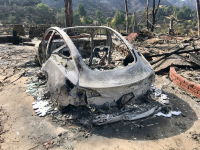This design prevents all Li-Ion cells from catching fire at once, EMBN claims. According to video, "the plastic is designed to melt around the cell". I couldn't find more info, but do you think this really works? Even if it does, many of us probably can't test if our DIY version of this would work.
Sorry if this has been talked about before, or if this is something old.

The above image is a screenshot from this YouTube Shorts video:
Sorry if this has been talked about before, or if this is something old.

The above image is a screenshot from this YouTube Shorts video:


